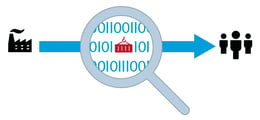How Should You Restart Your Supply Chain? With Turbo Transparency
Peter Asbeck - April 30, 2020

After weeks of lockdown, the industry is finally starting its cautious reopening in much of Europe. If we look to China as a blueprint for restarting the supply chain, it’s easy to envision a long road ahead—one in which capacity is ramped up gradually in accordance with strict guidelines on worker proximity and other health matters. In all likelihood, this will make for something of patchwork, with some plants and other facilities ramping up much more quickly than others.
This—and the uncertainty surrounding the emergence of new demand—puts planners in an unprecedented situation. Even the most agile of companies have their own version of business-as-usual, and there’s little hope that anyone will be able to fall back on that now. Procurement in particular will be thrown into disarray by the differences in ramp-up time between manufacturers and their suppliers. As such, planners who had previously been able to rely on the same sources for raw goods and the same shipping routes for finished products will have to begin replanning some of their most basic workflows virtually from scratch.
What does this mean in practical fact for modern supply chain planners? Simple—that now more than ever there’s no place for Excel spreadsheets in your planning processes. Instead, you need to take advantage of sophisticated, real-time planning capabilities.
Restarting the Supply Chain After Coronavirus
For the average automaker, you most likely have to contend with hundreds of thousands of parts from tens of thousands of sources in your day-to-day operations. Like you, those sources have had their operations on hold for several weeks, and it’s going to take time for them to ramp back to up to their pre-COVID-19 capacity levels. Nothing is going to go quite to your expectations, and the status of a given plant, a given order, or a given trip will be subject to change at a moment’s notice. The locations of parts and shipments in transit—to say nothing of the status of other links in the value chain—are often difficult enough to figure out in less volatile supply chain. For the immediate future, anyway, disruption and the unexpected will be the new normal.
Does this mean that even the most technologically-advanced supply chains should expect to operate inefficiently as various sectors of the economy reopen? Of course not! It just means that you’re going to need the right tools to manage disruptions as they arise. And what are the right tools? They’re the ones that let you know what’s happening at every touchpoint on the supply chain in real time, such that you’re able to coordinate with other departments to generate and operationalize the optimal plan in even the most volatile circumstances. To make this a reality, you need to be able to visualize the entire integrated planning horizon from your centralized supply chain control tower.
How Real-Time Planning Impacts Procurement
Let’s take a closer look at procurement as an example of a function that could be impacted significantly by the new realities of the supply chain. Here, your current stock levels will need to be visible in order to see which orders you can currently fulfill (within the bounds of your capacity restrictions). Those existing orders will have to be forecasted out using advanced analytics in order to give you a preview of what your raw material and stock needs might be for the short-, medium-, and long-term planning horizon. From there, you can create a rolling 12-month plan that automatically generates parts-demand information for procurement planners. This rolling demand plan gives you a critical point of reference as you begin to build out capacity.
Once you’re ready to start planning out fulfillment tactics for expected demand, you need an even more comprehensive overview that takes into account suppliers’ production times, transport times to ports, sea transport times, and transport times to production sites. You need to be able to monitor each of these factors and your overall demand coverage as you go, such that you can stay agile and continue to work with suppliers who are still getting on their feet. Again, disruptions will crop up, and you need to identify them and remediate them as quickly as possible—you simply don’t have the luxury of taking in information and performing calculations overnight; instead, you need a level of transparency that would have been difficult to imagine even a couple of decades ago.
flexis Turbo Transparency
This rapid growth of transparency is where flexis’ Turbo Transparency module comes in. This monitoring solution uses the techniques described above to merge operational planning and its execution into a single dynamic process. Rather than a patchwork of Excel spreadsheets that are only updated sporadically and difficult to access intra-operationally, the Turbo Transparency module enables planners at all touchpoints to monitor the supply chain situation as it unfolds. In this way, you can gain the information you need, when you need it, in order to plan quickly and responsively in changeable situations. Even in a pre-coronavirus world, this level of transparency would have been a significant value-added proposition—but as of now it’s hard to ignore the fact that a supply chain dominated by daily change demands rapid re-plannings, re-optimizations, and responses.
As with so many things, the transition back to some version of “normalcy” is going to be long and sometimes difficult. With capacity reduced in any number of areas, you might experience real difficulty sourcing parts that used to be abundant. The question is, when that difficulty arises, will you have the end-to-end visibility necessary to identify the potential shortfall in advance, find an alternate source, and uncover the ideal way of managing inventory and production to mitigate the cost of delays? Or will you be stuck with late order fulfillment and poor capacity utilization because you couldn’t see the disruptions coming? Our goal at flexis is to provide you with the tools to be in the former camp when your operations restart, i.e. to gain a real competitive advantage from a considerable increase in supply chain transparency.
LATEST POSTS
- Understand Circular Economy in The Manufacturing Industry
- How Can Industry 4.0 IT Integration Be Achieved Smoothly?
- The Significance of Order Sequencing in Discrete Manufacturing
- How to improve your Supply Chain Management: The Power of Control Towers
- Optimizing Human Resource Scheduling in Manufacturing: A Technological Approach



